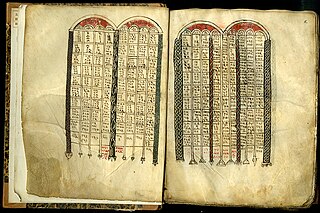Related Research Articles

Codex Tischendorfianus III – designated by siglum Λ or 039, ε 77 – is a Greek uncial manuscript of the Gospels on parchment. Palaeographically it has been assigned to the 9th or 10th century.

Codex Athous Dionysiou, designated by Ω or 045, ε 61, is a Greek uncial manuscript of the New Testament. The codex is dated palaeographically to the 9th century. It has marginalia.
Family Π is a group of New Testament manuscripts. Belonging to the Byzantine text-type, it is one of the textual families of this group. The name of the family, "Π", is drawn from the symbol used for the Codex Petropolitanus. One of the most distinct of the Byzantine sub-groups, it is very old and the third largest. The oldest Byzantine manuscripts belong to this family.
Family E is a textual group of the New Testament manuscripts. It belongs to the Byzantine text-type as one of its textual families, it is one of the primary early families of the Byzantine text-type. The name of the family came from the symbol of Codex Basilensis, the lead manuscript of the family, which is designated by symbol E.

Minuscule 113, ε 134 (Soden), is a Greek minuscule manuscript of the New Testament, on parchment leaves. Paleographically it has been assigned to the 11th-century.
Family Kr is a large group of the New Testament manuscripts. It belongs to the Byzantine text-type as one of the textual families of this group. The group contains no uncial manuscripts, but is represented by a substantial number of minuscules.
Family K1 is a small group of the New Testament manuscripts. It belongs to the Byzantine text-type as one of the textual families of this group. It has five uncials, and several early minuscules. It is one of the smallest subfamilies of the Byzantine text-type, but one of the oldest.
The Claremont Profile Method is a method for classifying ancient manuscripts of the Bible. It was elaborated by Ernest Cadman Colwell and his students. Professor Frederik Wisse attempted to establish an accurate and rapid procedure for the classification of the manuscript evidence of any ancient text with large manuscript attestation, and to present an adequate basis for the selection of balanced representatives of the whole tradition. The work of Wisse is limited only to three chapters in Luke: 1, 10, and 20.
Minuscule 533, ε 256, is a Greek minuscule manuscript of the New Testament, on a parchment, dated to the 13th century. It was adapted for liturgical use; marginalia are incomplete.
Minuscule 672, ε 156, is a Greek minuscule manuscript of the New Testament, on parchment. Palaeographically it has been assigned to the 11th century. The manuscript is a very lacunose. Scrivener labelled it by 618e.
Minuscule 686, Θε34, is a Greek minuscule manuscript of the New Testament, on parchment. It is dated by a colophon to the year 1337. Some leaves of the manuscript were lost. Scrivener labelled it by 573e.
Minuscule 759, ε397, is a Greek minuscule manuscript of the New Testament written on parchment. Palaeographically it has been assigned to the 13th century. The manuscript has complex contents. Scrivener labelled it as 848e. It has marginalia.
Minuscule 777, ε469, is a Greek minuscule manuscript of the New Testament written on parchment. Palaeographically it has been assigned to the 12th century. The manuscript has complex contents.
Minuscule 778, ε465, is a Greek minuscule manuscript of the New Testament written on parchment. Palaeographically it has been assigned to the 12th century. The manuscript has complex contents.
Minuscule 786, ε536, is a Greek minuscule manuscript of the New Testament written on parchment. Palaeographically it has been assigned to the 14th century. The manuscript has complex contents.
Minuscule 793, ε463, is a Greek minuscule manuscript of the New Testament written on parchment. Palaeographically it has been assigned to the 12th century. The manuscript has complex contents.
Minuscule 797, ε535, is a Greek minuscule manuscript of the New Testament written on paper. Palaeographically it has been assigned to the 14th century. The manuscript has complex contents.
Minuscule 799, ε196, is a Greek minuscule manuscript of the New Testament written on parchment. Palaeographically it has been assigned to the 11th century. The manuscript has complex contents.
Minuscule 1078 (in the Gregory-Aland numbering), A159 (von Soden), is a 10th-century Greek minuscule manuscript of the New Testament on parchment. It was adapted for liturgical use. The manuscript is not lacunose.
Minuscule 884 (in the Gregory-Aland numbering), A126 (von Soden), is an 11th-century Greek minuscule manuscript of the New Testament on parchment. The manuscript has not survived in complete condition.
References
- ↑ H. von Soden Die Schriften, I/2, p. 713.
- ↑ H. von Soden Die Schriften, I/2, pp. 734-757.
- 1 2 3 Wisse, Frederik (1982). The Profile Method for the Classification and Evaluation of Manuscript Evidence, as Applied to the Continuous Greek Text of the Gospel of Luke. Grand Rapids: William B. Eerdmans Publishing Company. p. 94. ISBN 0-8028-1918-4.
- ↑ Wisse, Frederik (1982). The profile method for the classification and evaluation of manuscript evidence, as Applied to the Continuous Greek Text of the Gospel of Luke. Grand Rapids: William B. Eerdmans Publishing Company. pp. 95, 122–125. ISBN 0-8028-1918-4.
- ↑ H. von Soden Die Schriften, I/2, p. 718
- ↑ F. Wisse, The Profile Method for the Classification and Evaluation of Manuscript Evidence, William B. Eerdmans Publishing , 1982, pp. 95-99.